The Belt and Road Initiative (BRI), proposed by Chinese President Xi Jinping in 2013, is an international initiative with vital implications for the economy, society, culture, and the environment. Consisting of the "Silk Road Economic Belt" and the "21st Century Maritime Silk Road", the BRI was inherited and developed from the ancient Silk Road that played an essential role in connecting the West with the East on various socio-economic levels with its spirit of peace, friendship, inclusiveness, openness, and mutual benefit for many centuries.
- the Belt and Road Initiative (BRI)
- environmental geography
- ecosystem services
- regional development
1. Introduction of the Belt and Road Initiative
The "Belt and Road" Initiative (BRI), i.e., the official Chinese term for the "Silk Road Economic Belt" and the "21st Century Maritime Silk Road", was proposed to share China's development opportunities with BRI-related countries and achieve common prosperity. As China's most ambitious long-term regional infrastructure project, the BRI primarily aims to provide unparalleled for international economic cooperation, enhancing trade and connectivity between Asia, Africa and Europe with terrestrial and maritime routes . Up to now, the BRI has officially involved 147 countries and 32 international organizations [1]. The BRI-related countries and regions constitute nearly 70% of the world’s population and account for more than 50% of global output [2]. It is projected that the population of Belt and Road countries (including China) will reach approximately 5.4 billion by 2030 [3]. The BRI will serve as a positive move toward cooperation among the Belt and Road regions, stimulating the economic momentum of member countries and countries along the routes. In addition, the BRI intends to increase understanding and trust among BRI-involved countries and aims to achieve policy coordination, infrastructure connectivity, unimpeded trade, financial integration, and person-to-person bonds in Asia, Europe, and Africa [4].
2. Current Status of the Belt and Road Initiative
The BRI has yielded fruitful results since it was proposed. From 2013 to September 2021, the cumulative value of trade in goods between China and BRI-involved countries amounted to USD 10.4 trillion [5]. In 2021, non-financial direct investment by Chinese enterprises in 56 countries along the Belt and Road routes amounted to USD 20.3 billion [6]. Furthermore, China–Europe freight trains have formed a grand channel for international trade spanning Eurasia. By the end of October 2021, a total of 73 routes for China–Europe freight trains had been launched, linking China with 175 cities in 23 European countries, and more than 46,000 trips had been made by these trains [5]. However, given the unprecedented dimensions of this initiative, many scholars have voiced concerns about its negative ecological and environmental impacts. Some have maintained that current official BRI investment remains heavily concentrated on fossil fuels, traditional forms of transportation infrastructure, and climate-unfriendly sectors [7]. Still, others argued that the changes in China’s policy priorities toward a greener economy could create a framework enabling China to outsource its polluting industries elsewhere while at the same time shifting its domestic economy to a new phase defined by the adoption of green technologies [8].
In fact, most countries and regions along the BRI routes are in sensitive zones of climate and geological change, with complex natural and fragile ecological environments. Therefore, it is understandable that socioeconomic development may sometimes be accompanied by some inevitable impacts on the ecology and environment. However, some scholars used the environmental consequences brought by the BRI as political attack tools and published their opinions with obvious political intent in scientific journals. RWesearchers found that some ecological issues were, to a certain extent, subjective assumptions. Regional ecosystem health and environmental problems are scientific issues that need to be addressed and researched scientifically and not to be politicized subjectively. Therefore, researcherswe try to use Cite Space to analyze the relevant papers published from 2013 to 2021 and review the ecological and environmental problems raised by the scholars in details. Meanwhile, researcherswe propose some suggestions for research issues on ecosystem health and environmental geography in the Belt and Road regions in the future.3. Quantitative Analysis of Environmental Studies Relating to the Belt and Road Initiative
3.1. Publications and Citations
To identify quantitative studies relating to the ecological issues of the Belt and Road regions, rwesearchers performed a systematic search of scientific literature from the ISI Web of Knowledge (www.isiwebofknowledge.com (accessed on 18 April 2022)), which provides access to peer-reviewed studies. RWesearchers conducted a pre-test, searching these databases for literature published between January 2013 and December 2021, and using the following search term combinations: (“belt and road” OR “silk road” OR “one road, one belt”) AND (“environment*” OR “ecosystem*” OR “ecolog*”). Finally, researcherswe obtained 623 qualified published references with related information on publication countries, years, authors, institutions, abstracts, keywords, journals, and their cited references. After checking the search results, rwesearchers found that “environment”, presenting polysemy, in most cases meant abstract background such as business environment or government-governance environment, which deviated from the ecological environment theme. Therefore, researcherswe adjusted the search term to give a more specific meaning to “environment”. Eventually, researcherswe obtained 470 requested records by retrieving the search term combinations (TS = “belt and road” OR “silk road“ OR ”one road, one belt”) AND (TS = “environmental” OR “eco-*” OR “pollution” OR ”emission” OR “ecolog*” OR “climat*”) and eliminating irrelevant articles. Meanwhile, researcherswe repeated the same operation on CNKI and obtained 108 English articles, only to find that they were completely covered by the ISI Web data. Since the BRI was first put forward in 2013, the ecology and environment of the “Belt and Road” regions have not obtained enough attention and there are few related publications from 2013 to 2015 (Figure 1). In 2016, the Chinese government released the 13th Five-Year Plan for ecological environment protection, which set the goals for a more environmentally friendly lifestyle, a considerable reduction in the discharge of pollutant emissions, effective control of environmental risks, and a sounder ecological system. As the concept of ecological civilization is deeply rooted in people’s hearts, promoting green Belt and Road to lead the international trend of green, low-carbon, and circular development is an inevitable and effective way to boost sustained and sound economic growth. In May 2017, relevant departments of the Chinese government jointly issued the “Guidance on Promoting a Green Belt and Road” to further promote the green development of the Belt and Road regions. Therefore, the number of related references has grown exponentially since 2017 (Figure 1). In recent years, environmental discussions in the Belt and Road regions have been sprouting up. As the topic becomes more attractive, the number of citations also increases yearly (Figure 1), which confirms the value of the research.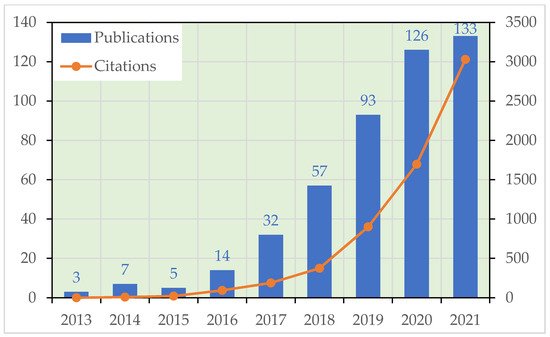
3.2. Interested Countries and Regions
CiteSpace is a scientometric software that can be used to generate knowledge domain visualization and detect emerging trends in scientific literature [9][10]. The retrieved articles were imported into CiteSpace 5.8.R3 for further analysis following the process: Time Slicing set as “From 2013 to 2021”, Link set as Cosine, and Selection Criteria set as g-index = 25. After processing, researchwers obtained the merged co-country network map with 48 notes and 166 links (Figure 2). Besides China, the main countries concerned about the ecological and environmental issues of the Belt and Road regions can be divided into 2 categories.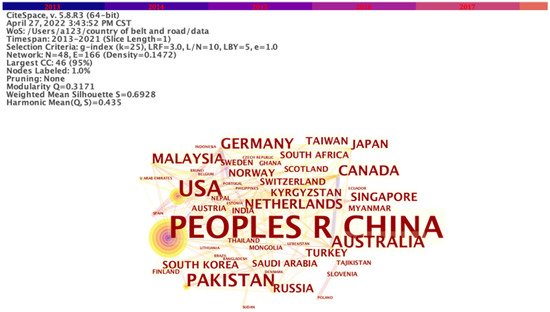
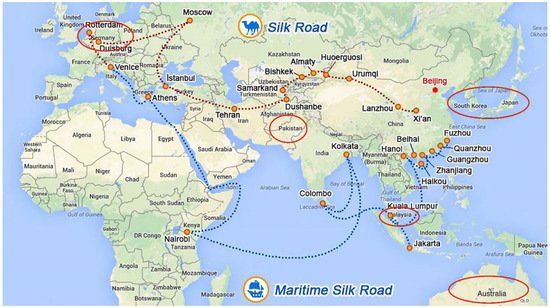
3.3. The Evolution of Research Hotspots
RWesearchers used CiteSpace 5.8.R3 to analyze the network of co-occurring keywords by setting pathfinder pruning (Figure 4). The knowledge network shows 320 notes and 609 links, resulting in 22 clusters. The top 11 clusters contain more than 10 keywords, displaying diverse research theses, study objects, and research methods (Figure 5). The modularity Q value is 0.812 and the silhouette S value is 0.9176, which mean that the structure of theour cluster data is clear and the results are reliable.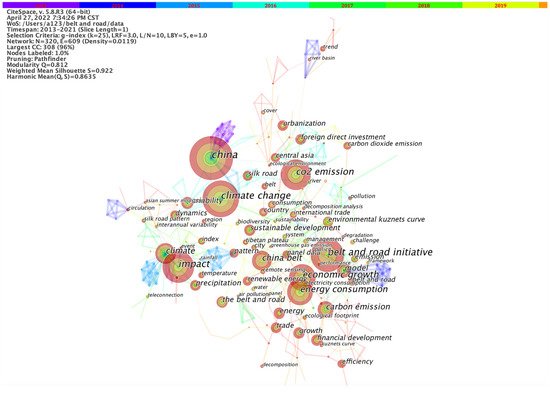
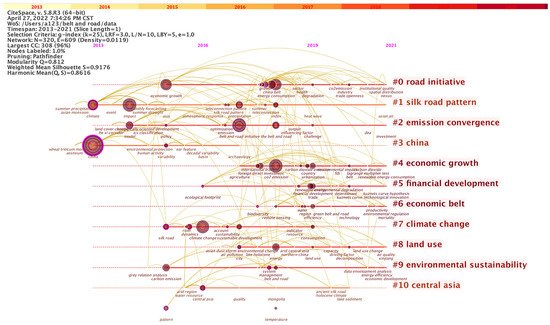
3.4. The Development Venation of Research
The visualized analysis of the references can reveal the intellectual base and research front of the research. The intellectual base is the co-citation venation, and the research front is the derivative of the knowledge base and represents the emerging research direction or subject [12]. ResWearchers still set the Selection Criteria as g-index = 25 and pruned the network using the pathfinder. The results are shown in Figure 6.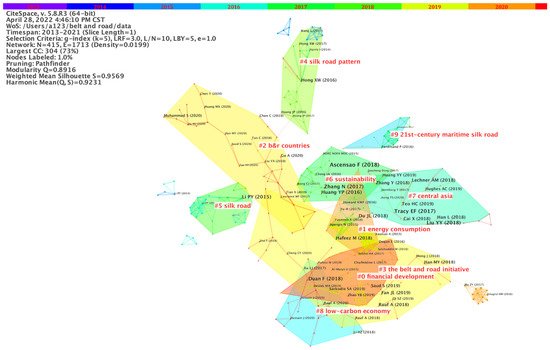
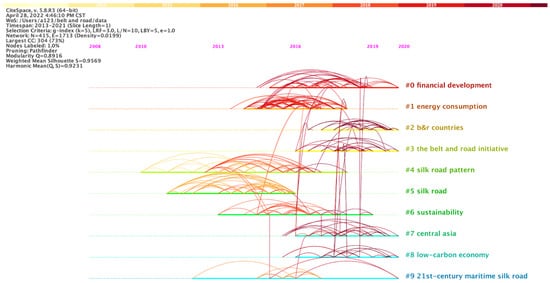
4. New Prospects for Ecological and Environmental Studies of the Belt and Road Initiative
In view of the potential environmental challenges proposed by scholars and the deficiencies in existing research, these environmental challenges should be addressed by scientific means. The focuses for future study on environmental challenges of the BRI are recommended as follows.
4.1. Spatial Analysis and Monitoring Technology for the Environment
The lack of comprehensive and up-to-date data is a key obstacle to in-depth research on the ecological environment of the BRI. Spatial analysis and monitoring technology can provide large-scale monitoring tools to obtain data on the status and changing trends of ecological and environmental quality. These scientific data can be used to judge the level of environmental pollution and quality, objectively evaluate the current main ecological and environmental problems. Therefore, to better and more objectively assess the ecologies and environments of the Belt and Road regions, more research is needed using spatial analysis and monitoring technologies
4.2. Clarification of Characteristics and Mechanisms of Ecosystems and Environments
4.2.1. Ecosystem Health
Ecosystem health, a kind of functional manifestation of ecosystem operation, can ensure the ecosystem develops well [21]. Ecosystem health is a comprehensive characteristic of the ecosystem, which can reflect the regional ecological environment from multiple perspectives. It can be described as a comprehensive, multiscale guiding framework in the evaluation of ecosystem vigor, organization, and resilience [22][23]. This evaluation mechanism of the ecosystem, comprising vigor (activity, metabolism, or primary productivity), organization (the diversity and number of interactions between system components), and resilience (the ability to maintain its structure and pattern of behavior in the presence of stress) [22][24], determines the assessment framework of ecosystem health and affects the identification of the regional environment. A systematic study of regional ecosystem health, therefore, can not only clarify the characteristics and spatial-temporal variations in regional ecological environments in the Belt and Road regions from multiple perspectives, but also contribute to the understanding of the driving mechanisms of regional ecological environmental change, providing a scientific basis for environmental protection under the BRI framework.
4.2.2. Environmental Impacts of the BRI
The potential impacts of the BRI proposed by scholars on the atmospheric, water, soil, geological, and biotic environment can be summarized and discussed. In addition, the driving factors of these effects (such as the factors affecting the carbon emissions by the transportation industry in countries in the BRI) and the direction and extent of these effects are both worthy of further discussion.
4.3. Focus on the Interactions between the Economy and the Environment
4.3.1. Regional Development and Ecosystem Health
As long as an ecosystem is healthy and well-protected, ecological and green industries can be developed to realize the economic value, thereby boosting regional development. Whether the ecological environments of the Belt and Road regions could support regional development and how to support it remain a largely unexplored area. Investigating the relationship between regional development and ecosystem health among these regions is the foundation for guaranteeing ecosystem health in order to promote regional development as a whole.
4.3.2. Economic Development and Ecological Protection
It is essential for future studies to attach importance to the relationship between development and protection. The relationship between economic development and the ecological environment should not be regarded as a zero-sum game. Does economic growth inevitably lead to ecological destruction? Is there a balanced model to achieve a "win-win" scenario for economic growth and environmental protection? Can this model be applied to future developments in the Belt and Road regions? These issues must be probed and clarified for further research.
4.4. Specific and Targeted Strategies and Solutions to Different Environmental Problems
Along with advances in BRI construction, infrastructure construction, export supply chains, and energy-intensive industries would surge, which could result in an increase in some unavoidable environmental problems such as greenhouse gas emissions, water pollution, and so on. Therefore, it is advisable to propose constructive strategies and solutions to environmental problems from different perspectives. Due to the different levels of development, financial status, sensitivity, and responsiveness to environmental changes in the Belt and Road regions, addressing environmental problems involved in the BRI is complex and multi-scaled. At the same time, the BRI infrastructure types could be divided into communication, transport, energy, and economic infrastructure and activities, all of which have different impacts on the environment. Therefore, it is essential to propose specific strategies and solutions to the environmental problems caused by various types of infrastructure in different regions.
References
- Belt and Road Forum for International Cooperation (BRF). Available online: http://beltandroadforum.org/english/n100/2017/0410/c22-45.html.
- Belt and Road Portal. Available online: https://www.yidaiyilu.gov.cn/xwzx/gnxw/215896.html.
- World Economic Forum. Available online: https://www.weforum.org/agenda/2021/11/belt-and-road-green-investment-delivers-on-climate-action/
- Shakib, M.; Yumei, H.; Rauf, A.; Alam, M.; Murshed, M.; Mahmood, H. Revisiting the energy-economy-environment relationships for attaining environmental sustainability: Evidence from Belt and Road Initiative countries. Environ. Sci. Pollut. Res. Int. 2022, 29, 3808–3825. https://doi.org/10.1007/s11356-021-15860-9.
- Huang, Y. Understanding China’s Belt & Road Initiative: Motivation, framework and assessment. China Econ. Rev. 2016, 40, 314–321. https://doi.org/10.1016/j.chieco.2016.07.007.
- National Development and Reform Commission (NDRC) People’s Republic of China. Available online: https://en.ndrc.gov.cn/news/mediarusources/202112/t20211201_1306613.html.
- MOFCOM (Ministry of Commerce of the People's Republic of China). Available online: http://www.mofcom.gov.cn/article/tongjiziliao/dgzz/202201/20220103239000.shtml.
- Center for Global Development. Available online: https://www.cgdev.org/blog/chinas-green-belt-road-initiative-isnt-very-green (accessed on 2 February 2022).
- Tracy, E.F.; Shvarts, E.; Simonov, E.; Babenko, M. China’s new Eurasian ambitions: The environmental risks of the Silk Road Economic Belt. Eurasian Geogr. Econ. 2017, 58, 56–88. https://doi.org/10.1080/15387216.2017.1295876.
- Chen, C. Searching for intellectual turning points: Progressive knowledge domain visualization. Proc. Natl. Acad. Sci. USA 2004, 101 (Suppl. S1), 5303–5310. https://doi.org/10.1073/pnas.0307513100.
- Chen, C. CiteSpace II: Detecting and visualizing emerging trends and transient patterns in scientific literature. J. Am. Soc. Inf. Sci. Tec. 2006, 57, 359–377. https://doi.org/10.1002/asi.20317.
- Chen, C.; Ibekwe-Sanjuan, F.; Hou, J. The Structure and Dynamics of Co-Citation Clusters: A Multiple-Perspective Co-Citation Analysis. J. Am. Soc. Inf. Sci. Tec. 2010, 61, 1386–1409. https://doi.org/10.1002/asi.21309.
- Cao, W.; Zhao, R. Evolution and frontiers of international agricultural diffused pollution research—Quantitative analysis based on CiteSpace. J. Arid. Land Resour. Environ. 2019, 33, 1–9. https://doi.org/10.13448/j.cnki.jalre.2019.190.
- Li, Y.Q.; Yang, S. A Dynamical Index for the East Asian Winter Monsoon. J. Clim. 2010, 23, 4255–4262. https://doi.org/10.1175/2010JCLI3375.1.
- Gong, D.Y.; Yang, J.; Kim, S.J.; Gao, Y.Q.; Guo, D.; Zhou, T.J.; Hu, M. Spring Arctic Oscillation-East Asian summer monsoon connection through circulation changes over the western North Pacific. Clim. Dyn. 2011, 37, 2199–2216. https://doi.org/10.1007/s00382-011-1041-1.
- Schinas, O.; Stefanakos, C.N. Cost assessment of environmental regulation and options for marine operators. Transp. Res. Part C: Emerg. Technol. 2012, 25, 81–99. https://doi.org/10.1016/j.trc.2012.05.002.
- Li, P.Y.; Qian, H.; Wu, J.H. Accelerate research on land creation. Nature 2014, 510, 29–31. https://doi.org/10.1038/510029a.
- Duan, F.; Ji, Q.; Liu, B.-Y.; Fan, Y. Energy investment risk assessment for nations along China’s Belt & Road Initiative. J. Clean. Prod. 2018, 170, 535–547. https://doi.org/10.1016/j.jclepro.2017.09.152.
- Dogan, E.; Turkekul, B. CO2 emissions, real output, energy consumption, trade, urbanization and financial development: Testing the EKC hypothesis for the USA. Environ. Sci. Pollut. Res. 2016, 23, 1203–1213. https://doi.org/10.1007/s11356-015-5323-8.
- Hong, X.W.; Lu, R.Y.; Li, S.L. Amplified summer warming in Europe-West Asia and Northeast Asia after the mid-1990s. Environ. Res. Lett. 2017, 12, 094007. https://doi.org/10.1088/1748-9326/aa7909.
- Kun-yu, C. Ecosystem health: Ecological sustainability target of strategic environment assessment. J. For. Res. 2003, 14, 146–150. https://doi.org/10.1007/BF02856782.
- Costanza, R. Ecosystem health and ecological engineering. Ecol. Eng. 2012, 45, 24–29. https://doi.org/10.1016/j.ecoleng.2012.03.023.
- Costanza, R. Toward an Operational Definition of Ecosystem Health. In Ecosystem Health: New Goals for Environmental Management; Costanza, R., Norton, B., Haskell, B.J., Eds.; Island Press: Washington, DC, USA, 1992; pp. 239–256.
- Holling, C.S. Resilience and Stability of Ecological Systems. Annu. Rev. Ecol. Evol. Syst. 1973, 4, 1–23. https://doi.org/10.1146/annurev.es.04.110173.000245.
